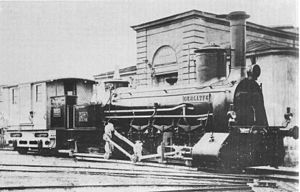StEG I 500-503
| StEG I 500–503 / StEG II 1401–1404 / MÁV TIVa 4270 | |
|---|---|
|
StEG I 502 GERLISTE coupled with a tender baggage car
|
|
| Numbering: | StEG I 500–503 StEG II 1401–1404 MÁV TIVa 4270 |
| Number: | 4th |
| Manufacturer: | Web |
| Year of construction (s): | 1862, 1864, 1867 |
| Retirement: | before 1911 |
| Type : | CB n2t |
| Gauge : | 1435 mm ( standard gauge ) |
| Length over buffers: | 9,324 mm |
| Height: | 4,530 mm |
| Width: | 2,924 mm |
| Fixed wheelbase: | 2,212 mm |
| Total wheelbase: | 5,873 mm |
| Empty mass: | 40.35 t |
| Service mass: | 42.4 t |
| Friction mass: | 42.4 t |
| Driving wheel diameter: | 1,000 mm |
| Number of cylinders: | 2 |
| Cylinder diameter: | 461 mm |
| Piston stroke: | 632 mm |
| Boiler overpressure: | 7.0 atm |
| Number of heating pipes: | 158 |
| Heating pipe length: | 4,425 mm |
| Grate area: | 1.4 m² |
| Radiant heating surface: | 7.7 m² |
| Tubular heating surface: | 115.3 m² |
| Evaporation heating surface: | 123.0 m² |
| Tender: | StEG tender baggage car |
The StEG I 500–503 were Engerth-Fink support tender locomotives of the Staats-Eisenbahn-Gesellschaft (StEG), a private Austrian-Hungarian railway company .
On the railway Oraviţa-Anina prevailed conditions similar to those on the Semmering Railway . There were gradients of up to 26 ‰ and curvatures of 114 m radius. The rails only allowed an axle pressure of 9.5 t. Pius Fink , an engineer at the StEG factory , therefore designed a five-way coupled Engerth locomotive, with the two-axle tender frame being connected to the wheels of the main frame via a jackshaft mounted above the frame. John Haswell first used his counter-vapor brake on these locomotives . A total of four of this series were manufactured in the StEG locomotive factory (one in 1862, two in 1864, one in 1867). StEG gave them the numbers 500–503 and the names STEYERDORF , KRASZOVA , GERLISTE and LISZAVA .
In practice, it quickly became apparent that the consumption of coal and water reduced the frictional weight of the tender machines so much that they could not be used in accordance with the wishes of the railway operators. The locomotives were therefore provided with sidecars designed to hold water and luggage.
In the designation scheme of 1873, the six machines were assigned the numbers 1401–1404 and category VI. By 1891 three of these extraordinary vehicles had already been taken out of service, so that only one more came to MÁV as the TIVa 4270 , where it was withdrawn from the inventory before 1911.
literature
- Overview of the locomotive park (and tender of the kk priv. Staats-Eisenbahn-Gesellschaft in Vienna) . Vienna 1879.
- Locomotive types of the kk landesbef. Machine factory in Vienna of the priv. Austro-Hungarian State Railway Company . M. Engel & Sohn, kk Hof-Buchdruckerei und Hof-Lithographie, Vienna 1888.
- Karl Gölsdorf: Locomotive construction in old Austria 1837–1918 . Slezak publishing house, Vienna 1978, ISBN 3-900134-40-5 .
- Mihály Kubinszky (ed.): Hungarian locomotives and railcars . Akadémiai Kiadó, Budapest 1975, ISBN 963-05-0125-2 .
